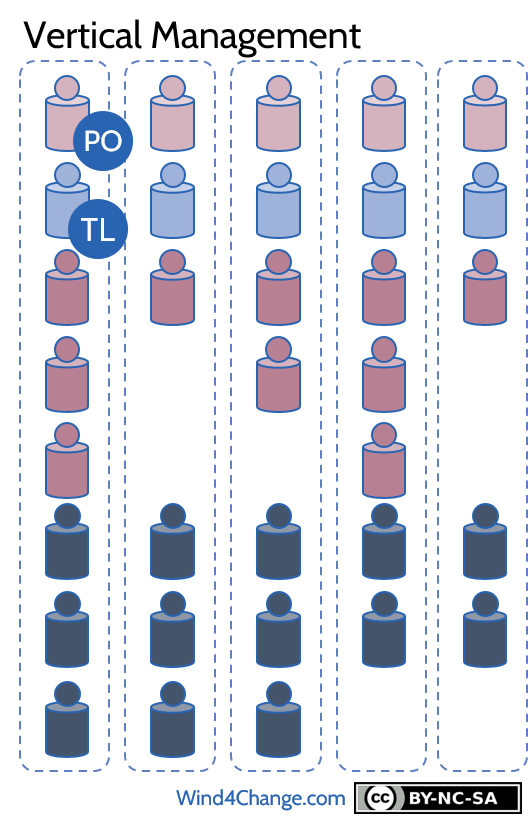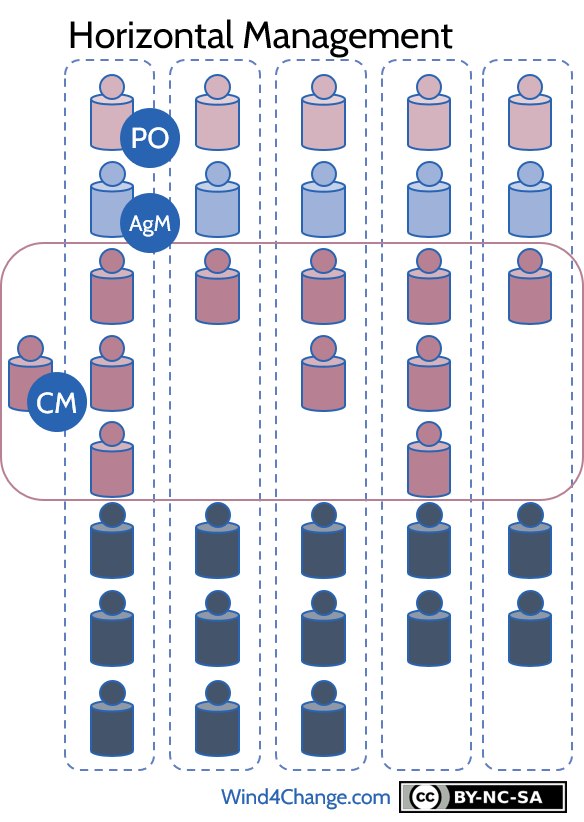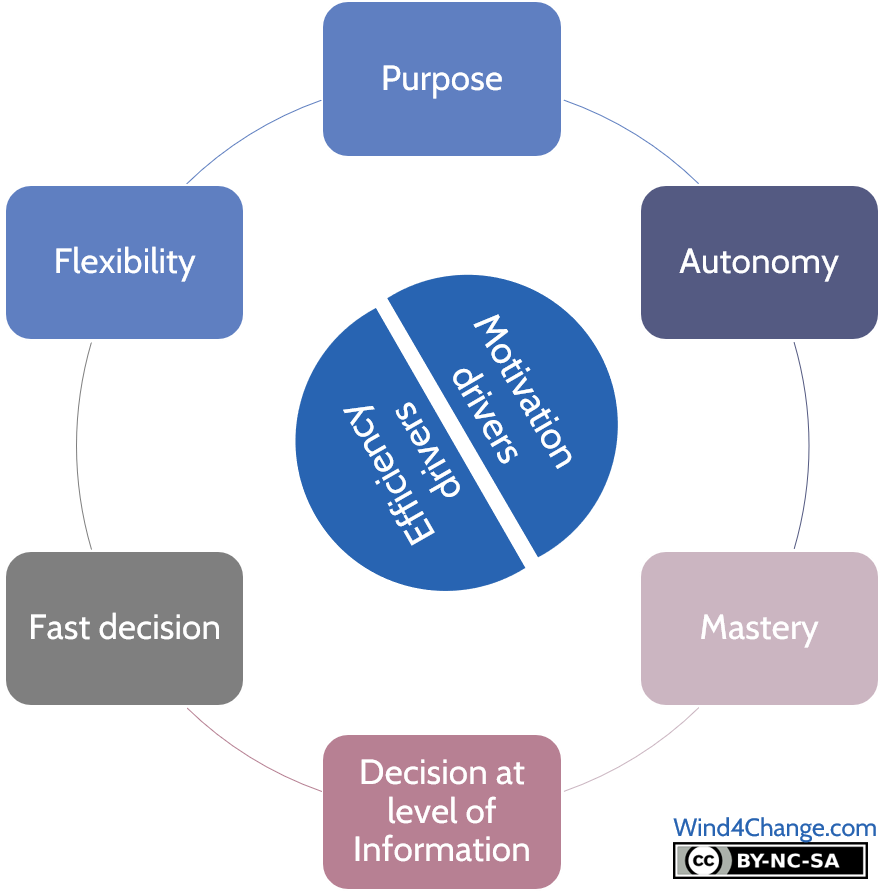What is horizontal management in Agile at Scale? And why going for it? In addition, what is the difference with vertical management? At last, what are the prerequisites for horizontal management and the Agile Squad’s empowerment.
What are vertical and horizontal managements in Agile at Scale?

This use of vertical and horizontal to describe the type of management comes from the Spotify Model that is a source of the Agile at Scale model.
By convention, Agile Squads are displayed vertically. When management is aligned with the Agile Squad, it is then vertical.
By the same convention, the chapters are displayed horizontally as they cross Agile Squads. When management is aligned with the Chapter it is then horizontal.
Firstly, what are the responsibilities of the manager in vertical management?
In this case, the Manager is the Team Leader:
- He/she is the leader with the Product Owner on the delivery of the team.
- He/she who develops and evaluates people.
- At last, he/she takes care of HR administrative aspects regarding team members.
Secondly, what are the responsibilities of the manager in horizontal management?

The Chapter Manager is outside the Agile Squad and has a scope of responsibilities that cross several Agile Squads with the same skills. He/she:
- is in charge of developing and evaluating people.
- also takes care of HR administrative aspects.
- does not interfere in Agile Squad’s delivery except to provide extra capacity or to work through the chapter and one to one coaching on how the Team Members work.
Horizontal management is the management approach in this Agile at Scale model.
The Scrum Master also called Agile Master is the Leader on the delivery of the Agile Squad with the Product Owner.
For more information about the changes in roles coming with Agile at Scale, read my post about reallocation of roles in Agile at Scale.
Why going for horizontal management in Agile at Scale?
Increase motivation in the Agile Squad

As we have seen in my post about the Influence Model, the motivation drivers as defined by Daniel Pink are Purpose, Autonomy and Mastery.
- In horizontal management, the manager is on the “how”, not on the “what”.
- This empowers on the delivery, the team and the Scrum Master, to be fully responsible and autonomous with their Product Owner.
- With this autonomy comes the mastery. When you do not have a conformable safety net as some expert managers can be, you are pushed to develop mastery.
- At last, the Scrum Master at target is a Team Member like the others. He/she as a special role of gatekeeper but he/she is not the manager of the members of the Agile Squad. This supports direct contact between the team members and the PO, therefore, more understanding of the purpose.
Increase efficiency in the Agile Squad
With the switch to horizontal management, the team takes the responsibility of the decisions regarding delivery not the manager.
- The closer the person who takes the decision is to the source of information, the better. This enables decisions that are more relevant but also faster as there is no intermediary.
- Decision taking at field level also supports more flexibility. This is the reason why the US Army developed the idea of command by intention. Once in the field, without any way to communicate with the hierarchy, the military team should be able to react with the context that is often quite different than expected.
In addition, horizontal management comes the decrease of management layers. This reinforce decision taking to be closer to the field.
What are the prerequisites of horizontal management and team empowerment in Agile at Scale?
Design of the Agile Squad
First, if it is not the case yet, there is the need to make teams as Agile Squads:
- Align them on the delivery, to say it differently on the features.
- Grant the Agile Squads with all skills to deliver the features. This is the initial configuration, as target is to develop multi-skilling.
- Co-locate team members to enable optimal collaboration.
See my post for more information about the Agile Squads’ design.
Operate the switch of manager’s stance to coach manager in the Chapter
Second, the manager needs to evolve to create the frame for the Agile Squad to build its autonomy:
- Prerequisite is of course that to train the manager and that he or she is willing to switch and become a host leader.
- Then, the team should be asked and accept the delegation. The scope of the delegation should be explicit and so the fact that the team takes responsibility. To sum up:
- Formal proposal from the manager to the Agile Squad to delegate delivery on a given scope and a given frame (level of quality, time to market, satisfaction of the customer/client…).
- Formal acceptance of the team of this responsibility.
The journey to Agile Squad’s autonomy: build hard and soft skills
Last not least, there is a transition so the the Agile Squad has all the hard and soft skills to be fully autonomous in the delivery. The manager closely working with the Scrum Master will build this autonomy as part of his/her role as coach manager.
This includes for the soft skills:
- Build autonomy and a proactive mindset
- Build multi-skilling and mechanism to develop them
What’s next? Learn more about Agile at Scale
Check my other posts about Agile at Scale:
- Review my posts on Agile at Scale foundations:
- What are
- What are the team topologies?
- How to synchronize Agile Squads in Agile at Scale when there are dependencies?
- Check another of my posts introducing Agile at Scale that leverages the book “Doing Agile Right”.
- Review my post on the Agile best practices from the GAO the Government Accountability Office from the USA.
- Read my posts on advanced topics around Agile at Scale:
- What are Leagues in Agile at Scale?
- How to design Agile Squads so they are aligned on the Value Chains.
- Why going for horizontal management? What does it mean and what is the value?
- How roles are reallocated with Agile at Scale?
- Check my posts on project management in Agile at Scale
- What is the impact of Agile on Project Management?
- How does Project Portfolio Management change with Agile at Scale?
- Then, how does Cost of Delay Divided by Duration (CD3) contribute to Agile at Scale?
- How does Beyond Budgeting support Agile at Scale?
- Can an Agile Project be fixed price?
- How to manage Release Management in Agile?
- Review my posts on how to forge a good strategy:
- What are competition and competitive advantage?
- What is a good strategy?
